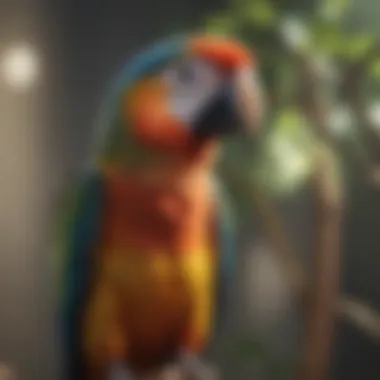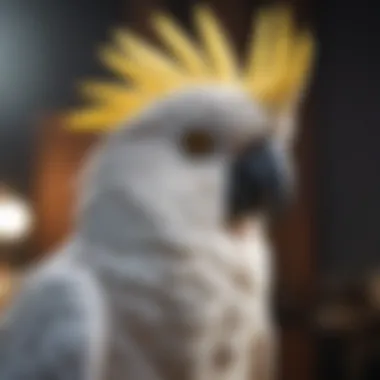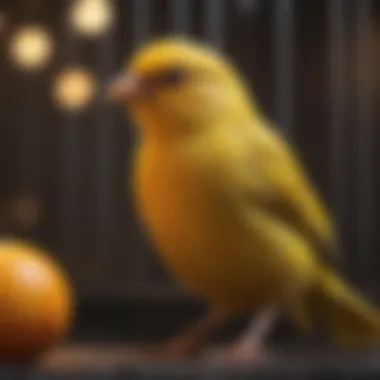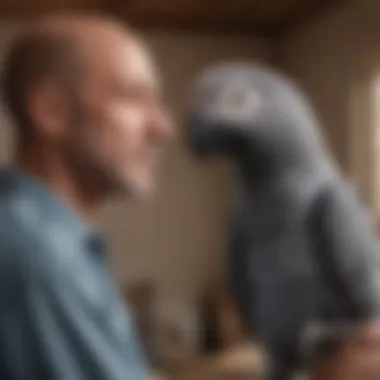Talking Birds as Pets: A Comprehensive Guide


Intro
Talking birds captivate many with their ability to mimic human speech and sounds. They are not just pets; they are companions, providing both entertainment and interaction. Understanding how to care for these intelligent creatures involves a deep dive into their behaviors, needs, and communication skills.
Understanding Your Pet
Pet Behavior Basics
Birds communicate through sounds and body language. Their vocalizations can indicate various emotions and needs. Understanding your pet's behavior is crucial in fostering a healthy relationship. For instance, a bird that is socialized properly should feel comfortable interacting with you. Watch for signs of distress such as excessive screeching or plucking feathers.
Common Breed Characteristics
Different species have unique characteristics. Parrots like the African Grey are known for their advanced mimicking abilities. Budgerigars, on the other hand, are smaller and often easier for beginners. Recognize these traits to choose the right bird that fits your lifestyle. Additionally, larger birds may need more space and social interaction than smaller ones.
Species-Specific Needs
Each bird species has its specific requirements. For example, cockatiels need regular social interaction, while lovebirds thrive in pairs. Understanding these needs will help you create the best environment possible. Knowledge about their dietary preferences and habitat requirements is vital for their wellbeing.
Pet Care and Maintenance
Feeding Guidelines
Proper nutrition is essential for your bird's health. Seed-based diets are common, but they should not be the sole source of nutrition. Include fresh fruits and vegetables in their diet. Be cautious with toxic foods, such as avocado and chocolate. Research the dietary needs specific to your bird species to ensure a balanced diet.
Grooming Essentials
Regular grooming keeps birds healthy. This includes trimming their nails and wings when necessary. Bathing your bird also contributes to feather maintenance, as they need to keep their plumage in top condition. Regular exposure to water allows birds to maintain their feathers effectively.
Hygiene Practices
Maintaining a clean environment is crucial for your bird’s health. Regularly clean the cage and replace bedding materials. Be aware of the bird's droppings as they can indicate health issues. Ensuring good hygiene prevents infections and illnesses, contributing to overall health.
Training and Development
Basic Commands and Skills
Training your bird enhances the bond that you share. Start with basic commands such as
Preface to Talking Birds
Talking birds create a curious intersection between the animal kingdom and human interaction. Their ability to mimic sounds and words can captivate anyone. This introduction lays the groundwork for understanding why these birds attract so much interest as pets. It establishes the base for discussing their unique communication skills, behaviors, and the responsibilities of their care.
Understanding Bird Communication
Bird communication is multifaceted and nuanced. Unlike human conversations, bird communication encompasses a range of vocalizations, body language, and behavioral signals. Talking birds, such as African Grey parrots and Amazon parrots, have a particular propensity for mimicking human speech. This mimicry is not merely a party trick; it reflects their ability to interpret and respond to their environment.
When birds talk, they are often mimicking sounds they hear frequently. This could include household noises, nature sounds, or, most significantly, the voices of their owners. Birds socialize through vocalizations. They use these sounds to establish relationships and convey their emotions. Understanding this communication allows pet owners to better interact with their feathered companions.
The Appeal of Talking Birds as Pets
Many people are drawn to talking birds for various reasons. First, the intellectual stimulation provided by these birds can be quite profound. Their capacity to learn and reproduce human speech makes them engaging companions. Many owners find joy in teaching their birds new words and phrases, which can strengthen the bond between them.
Moreover, talking birds often exhibit lively and playful personalities. This enthusiasm can contribute to a lively atmosphere in a home. The interaction and response from a talking bird offer a unique experience that is different from traditional pets. They give owners something more than unconditional love; they bring a sense of companionship that includes meaningful dialogue.
Consequently, potential owners must also consider the commitment involved. Talking birds require attention and social interaction to thrive. Their needs can sometimes demand more than what is typically required for other pets. Thus, while they can be incredibly rewarding companions, they also require a sincere commitment to their care and development.
Popular Species of Talking Birds
The realm of talking birds is vast and varied, with certain species standing out due to their remarkable ability to vocalize human language. This section highlights the most popular species frequently chosen as pets and discusses the unique traits that make them desirable companions. Understanding these species is crucial for potential bird owners, as it helps outline the necessary care, training needs, and the overall experience they can expect when bringing one of these intelligent creatures into their home. Each species has distinct characteristics, and learning about them allows for informed decisions, ensuring a rewarding relationship between the owner and their pet.
African Grey Parrots
African Grey Parrots are among the most renowned talking birds. They are famous for their impressive intelligence and exceptional mimicking abilities. These birds can learn a vast vocabulary and even pick up on context cues, making their communication quite nuanced. Its striking grey plumage and distinctive red tail adds to the visual appeal of this bird.
While they are delightful companions, they require significant mental stimulation and social interaction. Owners must engage in daily activities that challenge the bird, such as training exercises and interactive play. If neglected, African Greys may develop behavioral issues, manifested in excessive screaming or feather plucking.


Budgerigars
Budgerigars, often called budgies, are small parrots that also have conversational skills. They are among the most common pet birds due to their charming disposition and vibrant colors. The ability of budgies to mimic human speech, though limited compared to African Greys, remains impressive for their size.
Budgies thrive in social environments. Keeping them in pairs or flocks can encourage vocalization and socialization. They are relatively easy to care for, making them a suitable choice for first-time bird owners. However, consistent interaction is necessary to develop their speaking abilities.
Amazon Parrots
Amazon Parrots, known for their playful nature and vivid plumage, are celebrated for their vocal skills. They are social birds that enjoy interaction with their owners and can develop extensive vocabularies. Their ability to speak in clear, loud voices suitable for communication makes them a popular choice in homes.
These birds require ample space and plenty of playtime. Owners should ensure that they engage in frequent interaction and provide enrichment activities. With proper care and attention, Amazon Parrots can become charming and lively companions for many years.
Cockatoos
Cockatoos are known for their engaging personalities and notable affection. Many species of cockatoos can develop spoken language skills. They tend to bond closely with their owners, providing an enjoyable and interactive pet experience. Typically, their impressive crests and varying colorations draw attention.
Proper care for cockatoos is essential. They need mental stimulation and daily social interaction to remain happy. Without appropriate engagement, they might demonstrate challenging behaviors. Owners should dedicate time each day to bond and train their cockatoos effectively.
Eclectus Parrots
Eclectus Parrots are unique due to their sexual dimorphism, where males and females showcase different colors. Males are bright green, while females are striking red and purple. Known for their calm demeanor and enjoyable vocalizations, these parrots can learn a range of words and phrases.
They thrive with balanced diets and social interaction. Eclectus Parrots require patience in training, as their learning curve can vary. However, once established, they often make loving companions that contribute positively to the home environment.
Understanding these popular species of talking birds gives potential pet owners an advantage. Each bird comes with its specific needs and challenges, so prospective owners must consider which species aligns best with their lifestyle and experience. Investing time in learning about these captivating creatures before adopting one ensures a fulfilling relationship.
Training Talking Birds
Training talking birds is a fundamental aspect of proper bird care. It goes beyond mere vocalization and encompasses a spectrum of skills that enhance the overall relationship between the bird and its owner. Without training, a bird may become unmanageable or display undesirable behaviors. Thus, understanding how to effectively engage with these intelligent creatures is crucial.
Training not only nurtures vocal abilities, but it also contributes to the bird’s mental stimulation and emotional wellbeing. A well-trained bird usually exhibits less stress and more willingness to engage with its surroundings. It is beneficial for pet owners to become acquainted with key training principles, practical vocalization techniques, and positive reinforcement systems. These elements help establish a strong foundation for training that can yield impressive results.
Foundational Training Principles
When starting training with a talking bird, certain foundational principles are important. First of all, consistency is key. Birds thrive on routine, and having a specific training schedule helps reinforce learning. A pet owner should dedicate a few minutes each day to training sessions, ensuring they are free from distractions.
Additionally, patience is essential. Birds, like many animals, will not learn commands or vocalizations instantly. Therefore, it is wise to approach teaching with realism regarding the time commitment. Furthermore, understanding individual personalities is vital in this process. For example, some birds may respond better to specific methods or stimuli. Knowing your bird’s temperament assists in tailoring the training experience.
Effective Techniques for Vocalization
Teaching vocalization involves various techniques, and incorporating them into daily interactions can yield good outcomes. One effective method is modeling behavior. This means consistently using specific words or phrases in context while engaging with the bird. For instance, saying “hello” each time you enter the room will help the bird associate that phrase with your presence.
Repetition is also essential. Birds learn through mimicry, so repeating words often will create opportunities for the bird to practice. Engaging with audiovisual resources like videos of talking birds can provide additional motivation and context for learning. Birds can be curious, and exposure to vocalizations through media can enhance their eagerness to talk.
Positive Reinforcement Strategies
Utilizing positive reinforcement strategies is one of the most effective ways to train talking birds. This approach involves rewarding desired behaviors with treats, praise, or visual stimuli. For instance, if a bird successfully mimics a word or performs a trick, immediately offering a small treat helps reinforce the behavior.
Timing plays a crucial role in positive reinforcement. Offering the reward almost immediately after the desired behavior occurs strengthens the association between the action and the reward. Additionally, diversifying rewards can keep the training process engaging. Some birds may prefer specific treats or toys, while others may enjoy vocal praise or gentle petting as a reward.
In summary, effective training for talking birds hinges on understanding foundational principles, leveraging vocalization techniques, and applying positive reinforcement strategies. With dedication and respect for the unique abilities of these avian companions, a pet owner can cultivate a harmonious bond that enriches both their lives.
Care and Maintenance of Talking Birds
Caring for talking birds is essential to ensure they lead healthy and fulfilling lives. This section discusses key aspects of bird maintenance including diet, housing, and socialization. Each section highlights the significance of these elements not only for the well-being of the birds but also for the overall enjoyment of pet ownership.
Dietary Needs
A balanced diet is crucial for the health of talking birds. Different species have varying dietary requirements, but some commonalities exist. Fresh fruits and vegetables should make up a significant portion of their diet. Foods like carrots, spinach, apples, and berries present essential nutrients.
Here are important points regarding their diet:
- High-Quality Pellets: These provide necessary vitamins and minerals that seeds cannot alone furnish.
- Seeds in Moderation: While seeds are tasty and can be enjoyed, they should not be the primary part of the diet due to their high-fat content.
- Clean Water: Fresh water must be provided daily, and the container should be cleaned regularly to prevent contamination.
It is beneficial to monitor their intake and adjust portions based on their health and activity levels.
Housing Requirements


The housing for talking birds plays a significant role in their physical and mental health. Their cages should be spacious enough to allow free movement and exploration. At minimum, the cage should be larger than the bird to let them stretch their wings.
Considerations for housing include:
- Cage Size and Bar Spacing: Larger cages are ideal, especially for larger species. Bar spacing must be appropriate to prevent escapes or accidents.
- Location: The cage should be placed in a well-lit area, away from direct sunlight and drafts. Birds enjoy interaction; being part of the household activities enhances their well-being.
- Enrichment: Toys and perches should be provided to avoid boredom and encourage exercise. Rotate toys regularly for sustained interest.
Sufficient housing can keep birds active and reduce stress behaviors.
Socialization Needs
Socialization is key to the well-being of talking birds. They are inherently social animals and thrive on interaction with their human companions and other birds. Lack of social interaction can lead to behavioral issues.
Socialization practices include:
- Daily Interaction: Spend time with your bird each day. Talking, playing, and handling them can strengthen your bond.
- Introduce New Experiences: Introduce new sounds, sights, and people gradually to enhance their adaptability.
- Encourage Positive Interactions: Allow opportunities for your bird to meet other birds—in safe settings. This can be beneficial for their social development.
A well-socialized bird is generally more confident, enjoys vocalizations, and often exhibits a healthier demeanor.
Understanding and fulfilling these care requirements will contribute to a happier, more communicative bird. The effort in maintaining proper diet, housing, and social interactions will yield a rewarding companionship, allowing you to relish the unique bond shared with your pet. As such, these components are fundamental to the overall journey of owning talking birds.
Behavioral Aspects of Talking Birds
Understanding the behavioral aspects of talking birds is crucial for current and prospective owners. These elements play a significant role in how birds communicate, interact, and respond in their environments. Grasping these behaviors can lead to a more enriching and effective companionship between bird and owner. From understanding their typical behavioral patterns to addressing common issues, insights into avian behavior can enhance the overall experience of keeping a talking bird.
Understanding Typical Behaviors
Talking birds exhibit a range of behaviors that reflect their emotions, needs, and intelligence. One major aspect is their vocal communication. Birds like African Grey Parrots and Budgerigars are known for mimicking human speech. Their ability to imitate sounds depends on their social structure and environment. Communication can indicate happiness, curiosity, or stress.
Key behaviors include:
- Vocalization: Birds often use vocal sounds to communicate with their owners and other birds. Recognizing these sounds can help you understand their feelings and needs.
- Movement and Play: These birds are very active. They need space and opportunities for exercise. Play encourages mental stimulation and strengthens the bond between you and your bird.
- Grooming: Birds preen themselves as a way to maintain their feathers and demonstrate comfort. This behavior shows that they feel safe in their environment.
- Social Interactions: Talking birds are often social creatures. They enjoy interaction, not just with their owners but also with other birds if possible.
It’s vital for pet owners to observe these normal behaviors to create an environment where the bird feels secure and valued.
Common Behavioral Issues
Despite their charming nature, talking birds can experience behavioral issues, which may stem from stress, boredom, or inadequate care. Identifying these issues early is essential to prevent escalation.
Common issues include:
- Biting or Aggression: This can occur due to fear or perceived threats. Socialization and handling from a young age can help prevent this behavior.
- Screaming: Excessive vocalization may be a plea for attention or a sign of discomfort. Identifying triggers can help manage this behavior effectively.
- Destructive Chewing: Birds may chew on their surroundings out of boredom or to exercise their beaks. Providing chew toys can redirect this behavior positively.
- Feather Plucking: This can result from stress, health issues, or lack of stimulation. A vet's consultation may be necessary if this becomes a frequent occurrence.
Establishing a routine, ensuring proper environment, and keeping an eye on their behavior can make a significant difference in preventing issues. Providing them adequate stimulation, including toys and daily interaction, is paramount to maintain both their mental and emotional health.
Key Takeaway: Understanding typical behaviors and addressing common issues leads to a healthier, happier bird.
Recognizing the behavioral cues of your talking bird will help you create a nurturing environment. These aspects are not just about ensuring your beloved pet's well-being but also enhance the relationship you share with them.
Health Considerations for Talking Birds
Talking birds require a level of care that includes attention to their health. Understanding health considerations is critical for pet owners. This ensures the well-being of these intelligent creatures. Health problems can arise due to improper diet, lack of social interaction, or illness. That makes regular monitoring and veterinary care essential. Owners must know how to prevent health issues and recognize signs of illness.
Regular Veterinary Care
Regular veterinary visits are vital for talking birds. These appointments help to monitor the overall health of the bird. A vet can give vaccinations and perform health checks. Early detection of potential health issues is key.
Birds can hide their illnesses well. Therefore, a schedule of routine checks keeps them healthy. Pet owners should establish a relationship with an avian veterinarian experienced in treating birds. This will provide peace of mind when questions or emergencies arise.
During a check-up, the veterinarian will examine feathers, body condition, and weight. They may also perform blood tests or other diagnostic tests. Such preventive care can potentially extend the life of your talking bird. Consider the following aspects during veterinary visits:
- Vaccinations: Ensure your bird receives all necessary vaccines.
- Dietary advice: Veterinary visits are a good time to discuss proper nutrition.
- Behavior assessment: A vet can help understand changes in behavior that may indicate health issues.
Signs of Illness
Recognizing illness is crucial for the health of your talking bird. Birds often exhibit subtle signs that indicate something is wrong. Being aware of these signs allows for timely intervention. Common symptoms of illness in birds include:
- Changes in vocalization
- Fluffed feathers
- Lethargy or inactivity
- Changes in eating or drinking habits
- Nasal discharge or excessive sneezing
- Diarrhea or changes in droppings


If you observe any of these signs in your talking bird, consult a veterinarian immediately. Regular observation is essential. Keeping track of every behavioral change can aid in prompt diagnosis and treatment.
"A healthy bird is a happy bird. Regular care and attention to their health needs can lead to a long, fulfilling relationship with your avian companion."
Understanding both the need for regular veterinary care and the signs of illness can greatly enhance the life quality of your talking bird.
The Human-Bird Bond
The bond between humans and their talking birds is profound and multifaceted. This relationship goes beyond mere companionship; it involves communication, trust, and emotional connection. Understanding the dynamics of this bond can enhance the experience for both the bird and the owner, making it a crucial topic to explore.
Building a Relationship with Your Bird
Establishing a strong relationship with your bird requires time and effort. Patience plays a significant role in this process. Each bird has its unique personality and preferences. Spend time observing your bird's behavior to understand its likes and dislikes. Building rapport can start with small steps, such as talking softly to your bird as you approach its cage or offering treats after positive interactions.
Techniques for Effective Bonding:
- Regular Interaction: Daily engagement is key. Talk to your bird, and let it get used to your voice and presence.
- Gentle Handling: Gradually desensitize your bird to being touched. Start with short sessions of gentle handling to build trust.
- Playtime: Provide toys and opportunities for play. Engaging your bird in play cultivates a sense of safety and enjoyment.
These methods can foster trust and strengthen your bond over time. As the relationship develops, you may find that your bird begins to exhibit affection and willingness to communicate vocally.
Long-term Commitment
Owning a talking bird is not a fleeting interest; it is a long-term commitment. Birds, especially those known for their talking abilities, can live for decades. Thus, it is essential to prepare for a responsibility that extends far beyond a few years.
Important Considerations for Long-term Care:
- Lifespan Awareness: Different species have varying lifespans. For instance, African Grey Parrots can live for up to 50 years, while some Cockatoos can exceed 70 years.
- Consistent Care: Regular social interaction, proper diet, and veterinary check-ups are essential for the bird's well-being. Neglect can lead to health issues and behavioral problems.
- Adapting to Changes: Life circumstances may change, but your bird will still need a stable environment. Be ready to make adjustments in your living situation to accommodate its needs.
It is crucial to consider your personal commitment and living situation before bringing a bird into your home. The human-bird bond can be incredibly rewarding, but it requires the readiness for a relationship that lasts a lifetime.
Owning a talking bird is a journey of companionship, trust, and mutual understanding, where every interaction leads to an enriching experience.
Challenges of Keeping Talking Birds
Talking birds can be incredible companions, but potential owners must recognize that they come with specific challenges. Owning a talking bird is not just about enjoying their vocal skills; it also demands a good deal of commitment, understanding, and awareness of how to cater to their needs. Being informed about these challenges can lead to a more satisfying experience for both the owner and the bird.
Time Investment
One of the primary challenges in keeping talking birds is the significant time commitment they require. Unlike many pets, birds like African Grey Parrots or Amazon Parrots thrive on social interaction. They need daily engagement for their physical and mental well-being.
Training a talking bird takes patience and engagement. Regular practice sessions are essential for fostering vocalization skills. Birds can learn new words and phrases quickly, but it often requires frequent repetition and encouragement. A few minutes each day is not enough; many bird owners find that dedicating an hour or more each day to socializing and training their birds yields the best results.
A Noise Consideration
Noise is another critical factor to consider. Talking birds can be quite vocal, and the sounds they make can vary greatly from soft sounds to loud squawks. For families or individuals living in shared spaces, this can be a source of inconvenience. African Grey Parrots, for example, are known for their clear vocalizations, but they can also scream if they feel neglected.
Understanding a specific breed's temperament and vocalization patterns is crucial. Owners may need to establish a routine that minimizes noise during certain times, especially if there are young children or anyone with noise sensitivity in the household.
Understanding Their Lifespan
The lifespan of talking birds is another essential consideration. Many species can live for several decades, with some like the Macaw living up to 50 years or more. This longevity implies that owning a talking bird is a long-term commitment.
Prospective bird owners must evaluate their life circumstances, making sure they can provide a suitable environment for the bird throughout its life. This includes not just daily care but also planning for situations like potential relocation, significant life changes, or even grief over a bird's eventual passing.
"Thinking about a bird's lifespan is important. They are part of the family for many years."
Epilogue
Talking birds as pets offer unique companionship that enriches the lives of their owners. This article has examined several key aspects related to these fascinating creatures. We explored the distinct characteristics of species known for their ability to vocally mimic human speech, such as African Grey parrots and cockatoos. Understanding how to facilitate their communication skills is crucial.
The Rewards of Having a Talking Bird
Owning a talking bird can be rewarding in numerous ways. For many, the joy of hearing their pet repeat phrases or even tell stories can create delightful interactions. These birds are often intelligent and can form strong bonds with their owners, leading to a fulfilling relationship.
Benefits include:
- Companionship: Talking birds provide the emotional support that many seek in a pet.
- Cognitive Engagement: Engaging training sessions can stimulate both the bird and the owner, fostering a rewarding learning experience.
- Entertainment: Their vocalizations can bring humor and light-hearted moments into one’s home.
"The ability of birds to mimic human speech deepens the connection between owner and pet, enhancing everyday life significantly."
Final Thoughts on Pet Birds
Thus, for enthusiasts and new pet owners, understanding the complexities of caring for a talking bird can lead to remarkable rewards. Each interaction with a talking bird enriches the human experience, making the investment in their care profoundly worthwhile.







